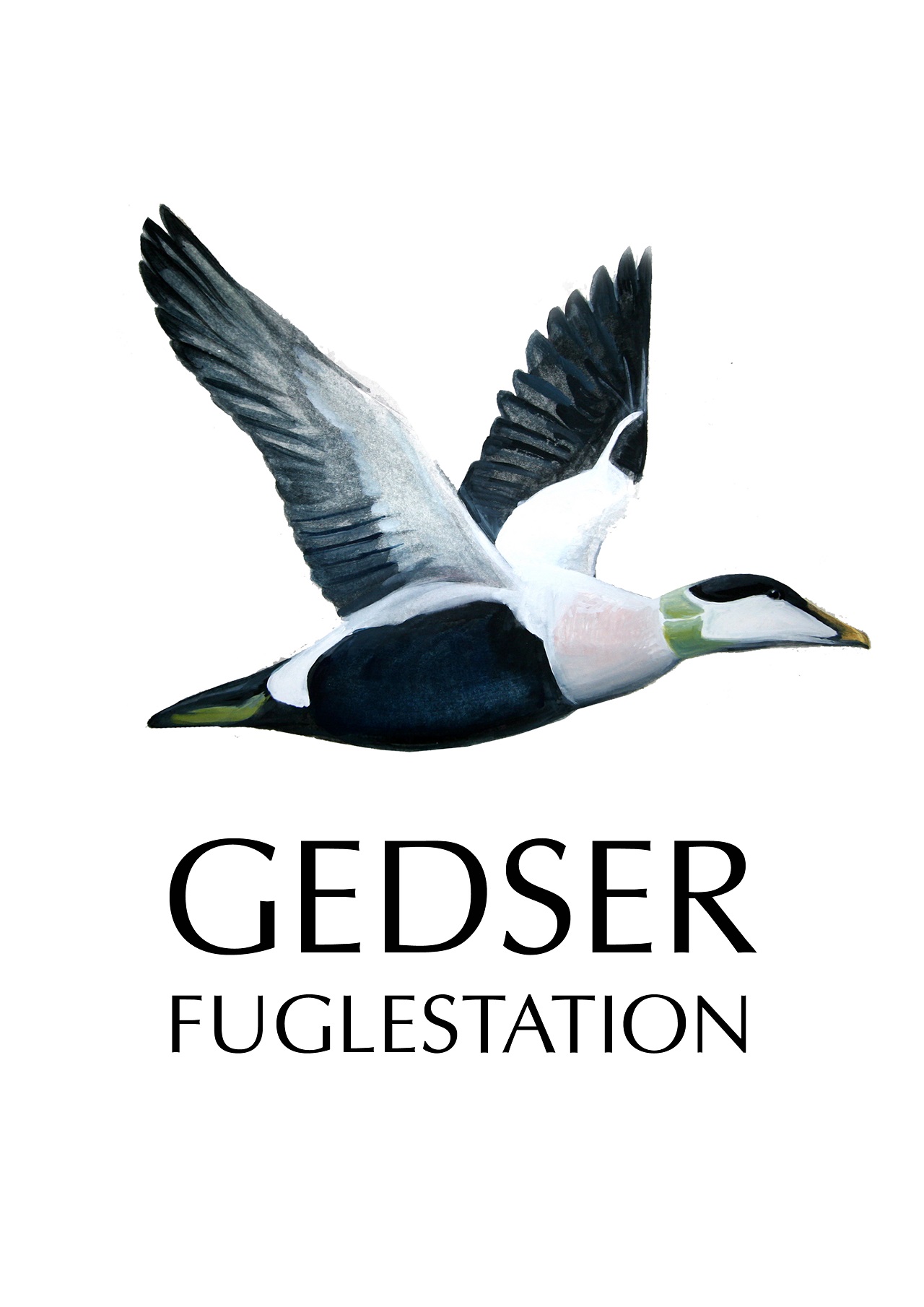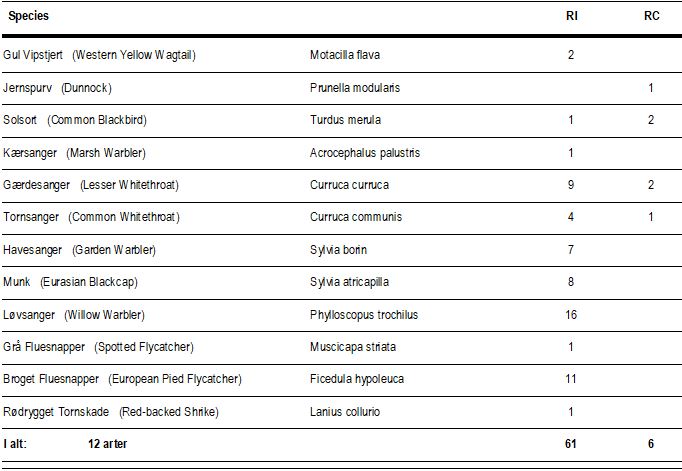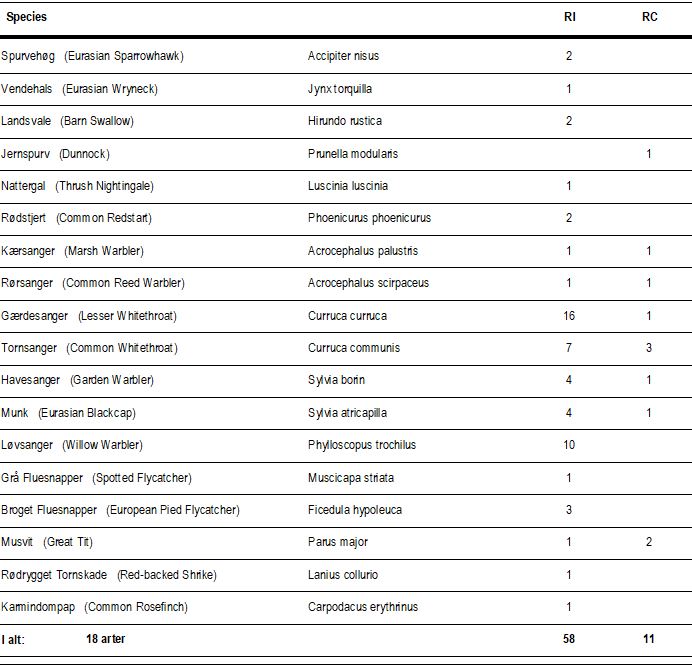Gedser Fuglestation Blog
Her på Gedser Fuglestations blog bringes korte nyheder i dagbogsformat om hændelser på fuglestationen.
Se indlæg fra måned: feb. (2)mar. (31)apr. (30)maj (31)juni (15)juli (17)aug. (31)sept. (30)okt. (31)nov. (29)dec. (18)
Gærdesangeren, en af ringmærkningens ubesungne helte
The Lesser Whitethroat - one of bird bandings unsung heroes (2/5)
A short series in five parts on that which we take for granted in bird banding.
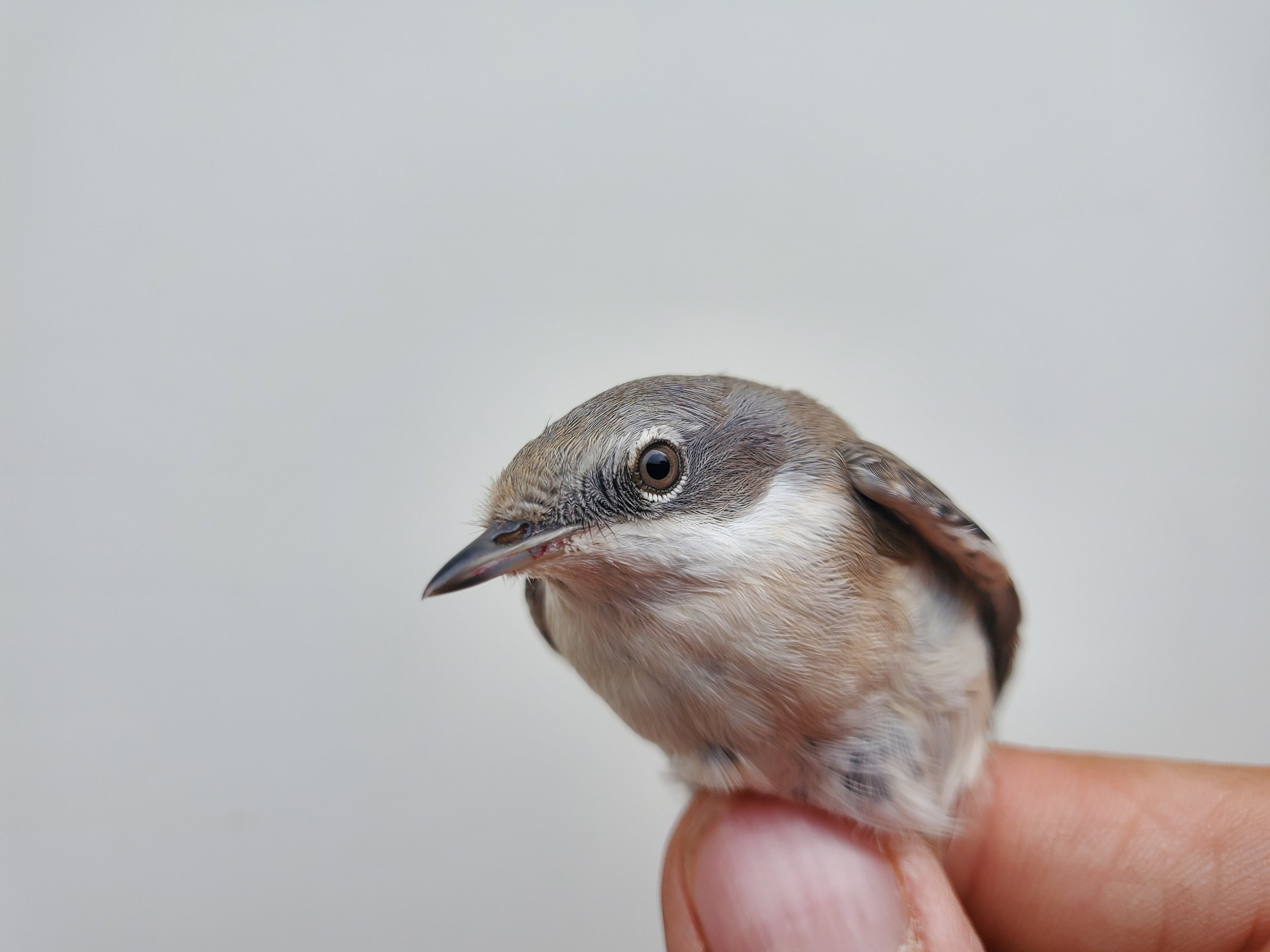
The 10-14 gram warbler with its diminitative name deserves praise as one of the tell-tale birds of autumn migration in Denmark. Rarities get more shine, but Lesser Whitethroat dominates the garden soundscape at the station, and the nets too, as we venture into the autumn months. The oft forgotten but not necessarily shy migratory bird took center stage last year as it was elevated to the scientific name Curruca curruca. Like most other longdistance migrants, the species is seeing a decline in Europe over the last decades.
Den lille 10-14 gram tunge sanger, som vi ikke fremhæver ofte er faktisk lidt af en karakterfugl i Gedser fuglestations have, både rent auditivt men egentlig også i nettene på denne tid. Foroven set med et svagt brombæroverskæg.
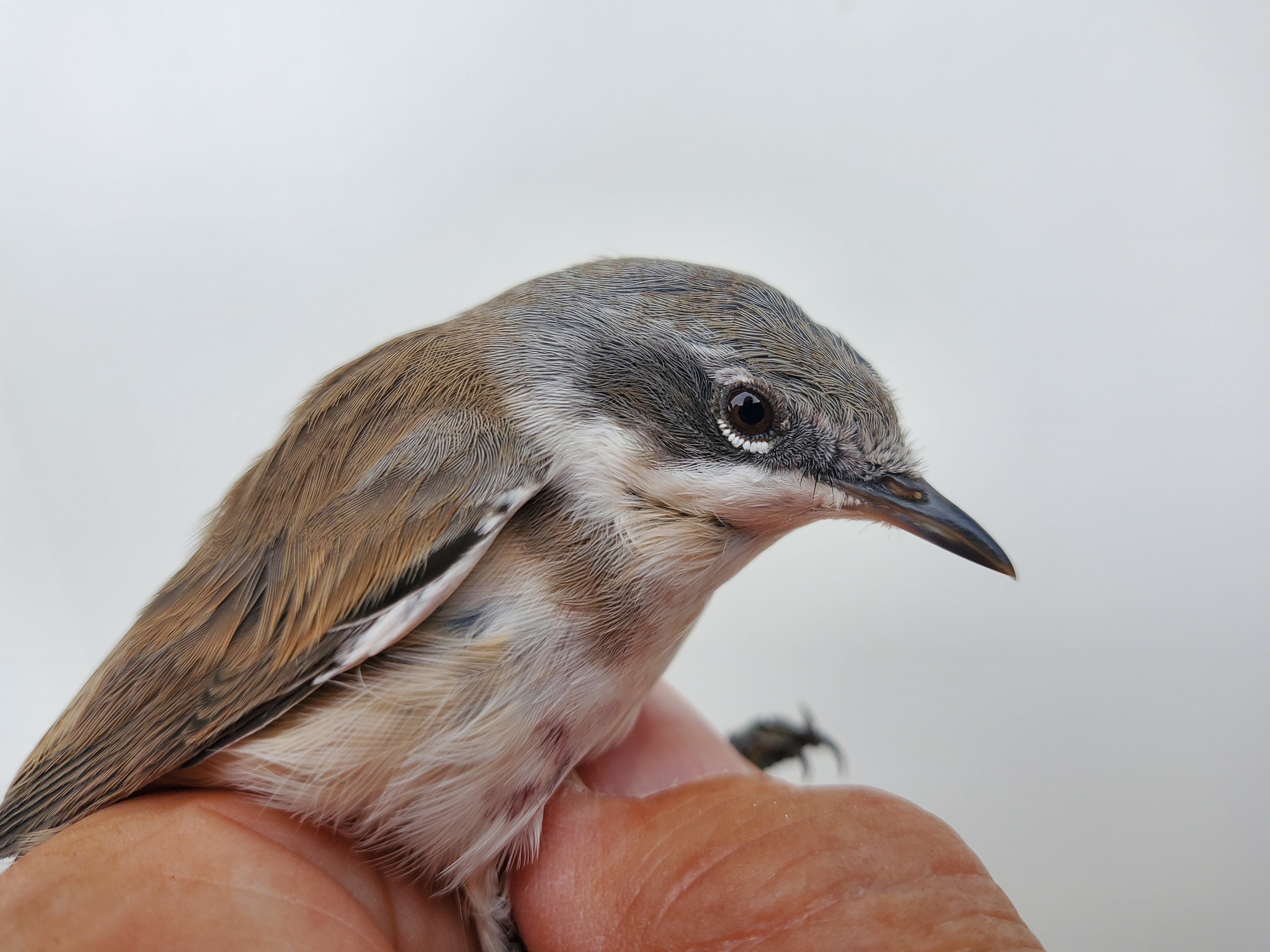
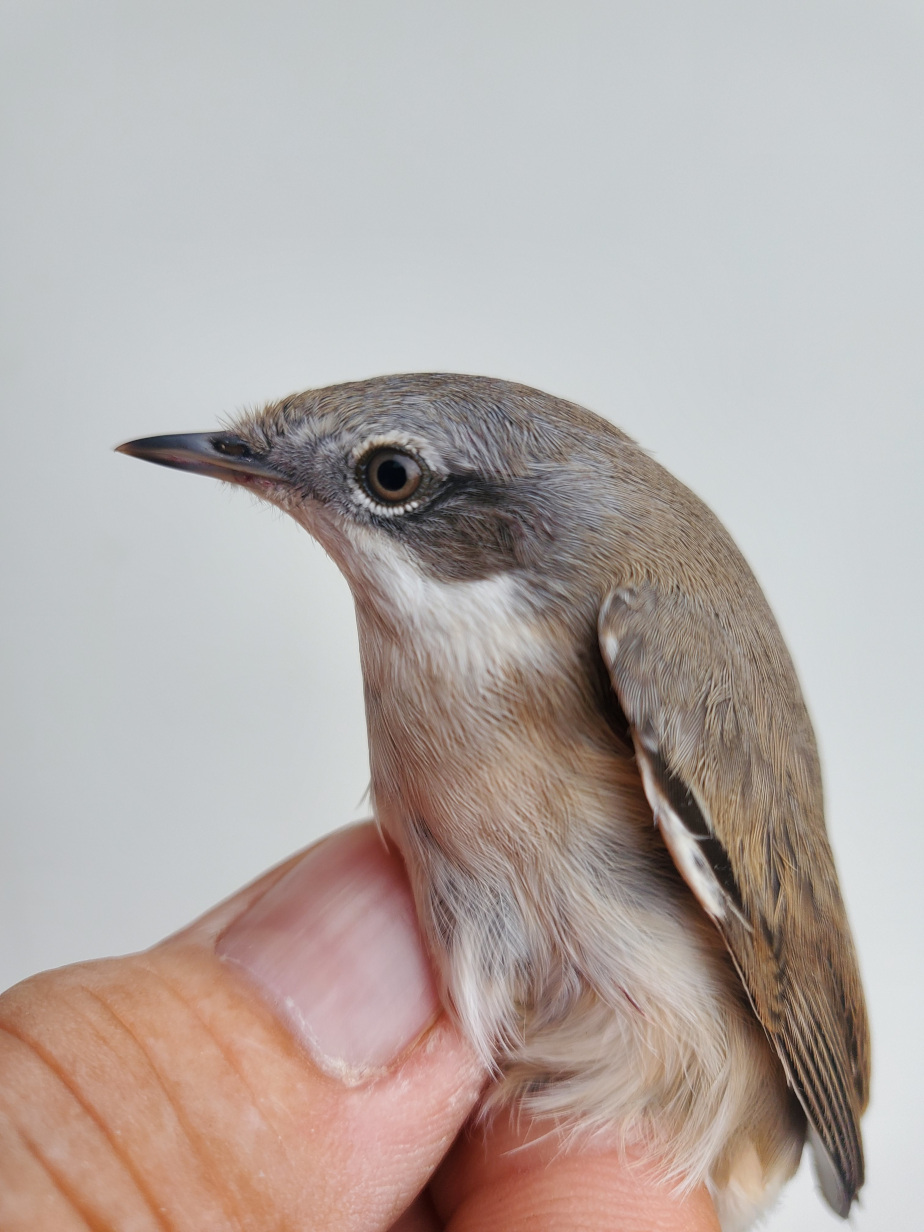
Gærdesangeren kan ikke kønsbestemmes, men normalt kan alderen bedømmes. Fuglen oven over er juvenil, først når fuglen når sit andet kalenderår kan den udvikle en lys halvmåne i iris'en, een af få kendetegn som hjælper med aldersbestemmelse.
Der blogges typisk mer' om spektakulære fuglearter med pragt dragt, vendende hals, vingebånd eller øjenstribe - særligt i efterårssæsonen - men hverdagshelte fortjener tillige at blive anerkendt for alt det de kan. Siden juni er gærdesangeren klart den hyppigste fugl i nettene med 377 individer ringmærket - lidt under gennemsnittet for sommermånederne de seneste fem år på stationen. Kun tornsanger og løvsanger plejer at kunne konkurrere i antal, men i år er særlig den sidste af de to tilsyneladende forsinket i deres ryk sydpå.
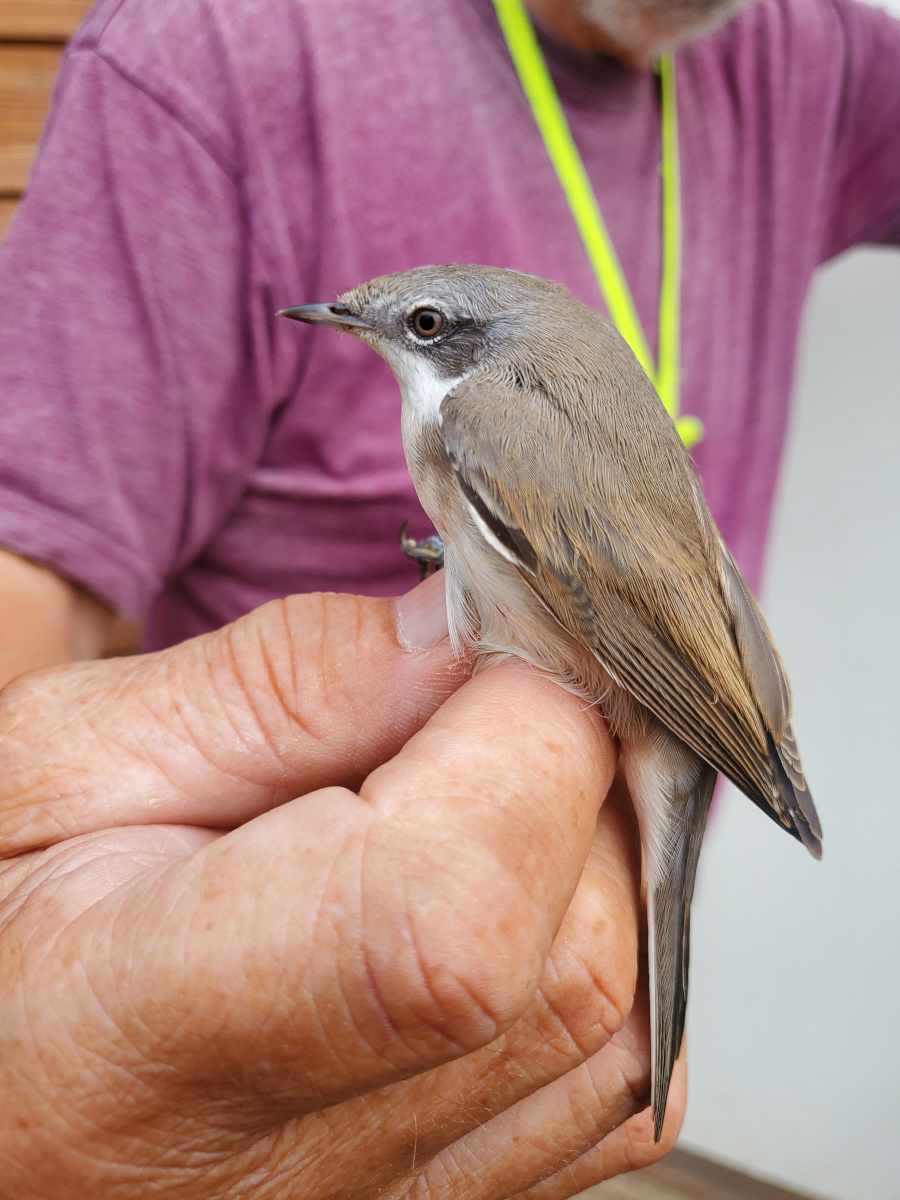
Afrikatrækkeren gik i folkemunde under navnet mølleren da den lyder som et vandmøllehjul teck-teck-teck-teck hvad det tilsvarende tyske navn Klappergrasmücke også fortæller. I 2021 fik gærdesangeren et veltjent popularitetsboost da den skiftede videnskabeligt navn fra Sylvia curruca til nu at være nominal art med navnet Curruca curruca.
Som øvrige langdistancetrækkere er populationen af gærdesangeren også faldende i Europa de seneste årtier. Trods gærdesangers mindre statur og til tider oversette tilstedeværelse er det på ingen måde en fugl, der kan undværes her på landets sydligeste spids.
Dagens mærkningstal:
Todays numbers:
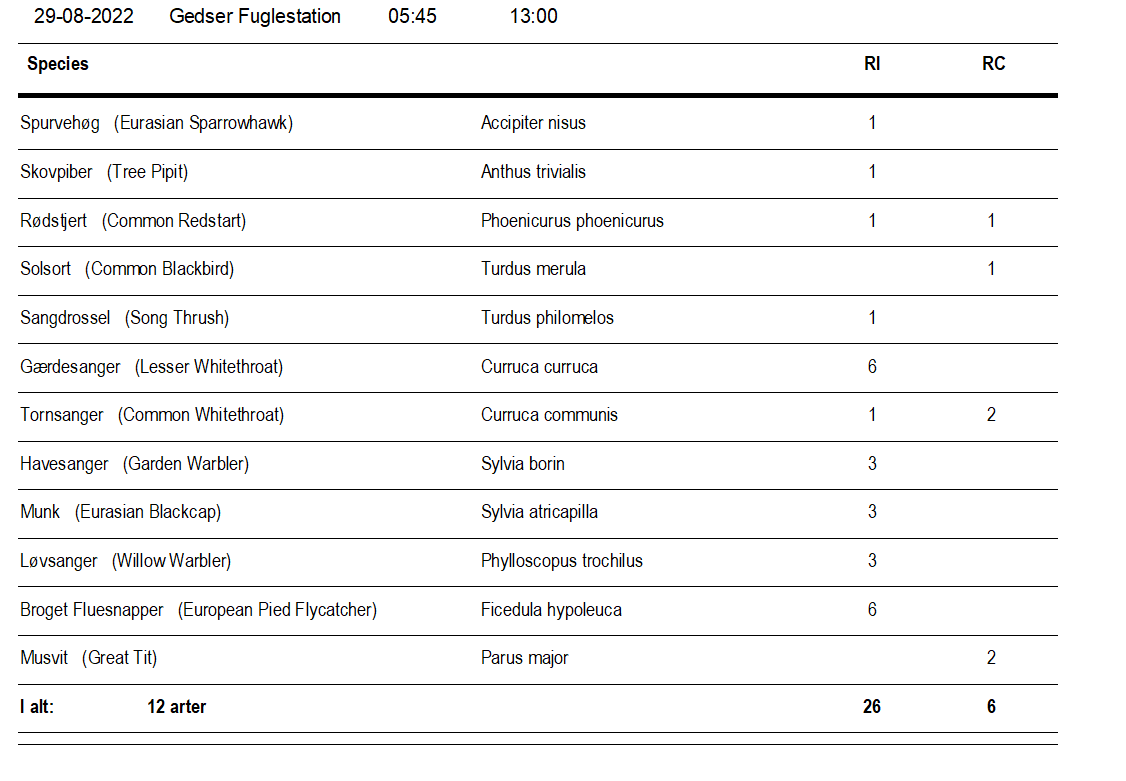 Mandag morgen blev en gruelig musestille ringmærkningsforestilling, men det lykkedes altså ringmærkerholdet at finde 26 fugle med 12 arter frem inden vi lukkede igen sent på formiddagen.
Mandag morgen blev en gruelig musestille ringmærkningsforestilling, men det lykkedes altså ringmærkerholdet at finde 26 fugle med 12 arter frem inden vi lukkede igen sent på formiddagen.
Ude på Odden var trækket ik' særligt talrigt, men lidt rovfugl var der med en enkelt dværgfalk, steppehøg og to fiskeørne.
På stationen: Adam, Ole Friis Larsen og Lars Ulrich Rasmussen
Spejlnettet, en af ringmærkningens ubesungne helte
The Mistnet - one of bird bandings unsung heroes (1/5)
A short series in five parts on that which we take for granted in bird banding.
Pænt sensommervejr denne eftermiddag var en kærkommen lejlighed for lidt vedligehold af vores net, udstyr som i alt dets simplicitet vi måske nogen gange tager for givet.
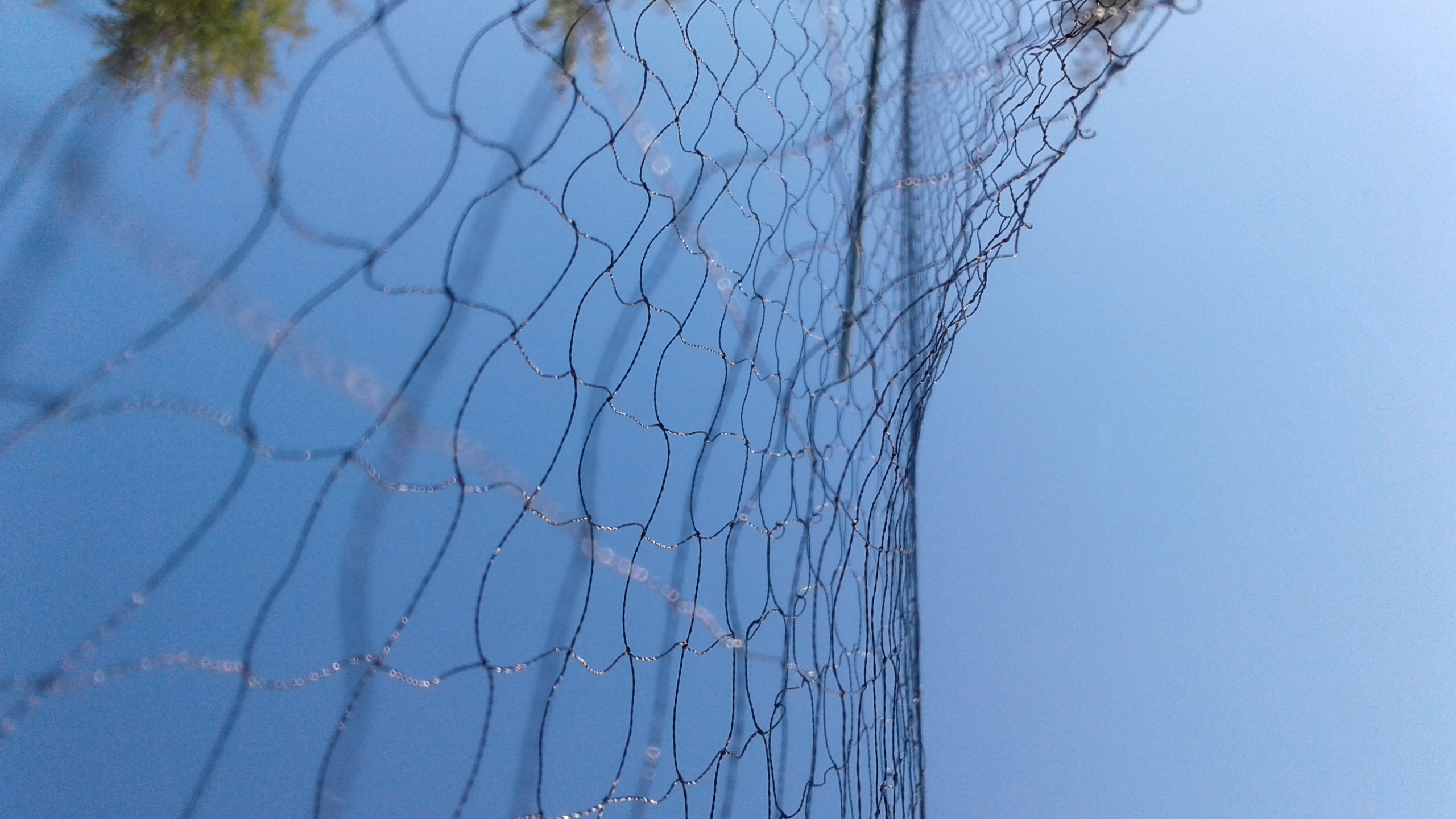
Spejlnettet er et specialnet som bruges i ringmærkningen og flagermusfangst.
De sorte nylonnet fungerer bedst på en mørk baggrund, og kan næsten ik’ ses medmindre de er udsatte for vind. De er bygget med små horisontale lommer som fuglene falder ned i når de rammer nettet. Derved er nettene beregnet til bestemte fuglearter; altså netmasker tilpasset en vis størrelse af fugl.
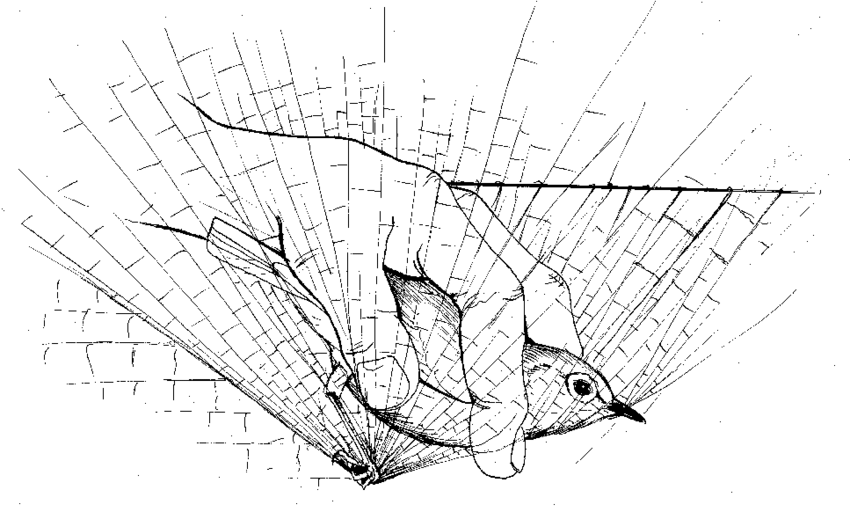
Rigtig mange af vores net er 12 meter i længden og godt 2.50 meter høje, men i haven har vi også to hejsenet som altså han hejses op til over det dobbelte, til f.eks af nå en fræk grønsisken, og midt i haven står to spurvehøgenet med lidt større netmasker end de øvrige.
I alt er det 284 netmeter, og så har vi også fire net stående rundt om et vandhul til fangst uden for vores videnskabelige standard.
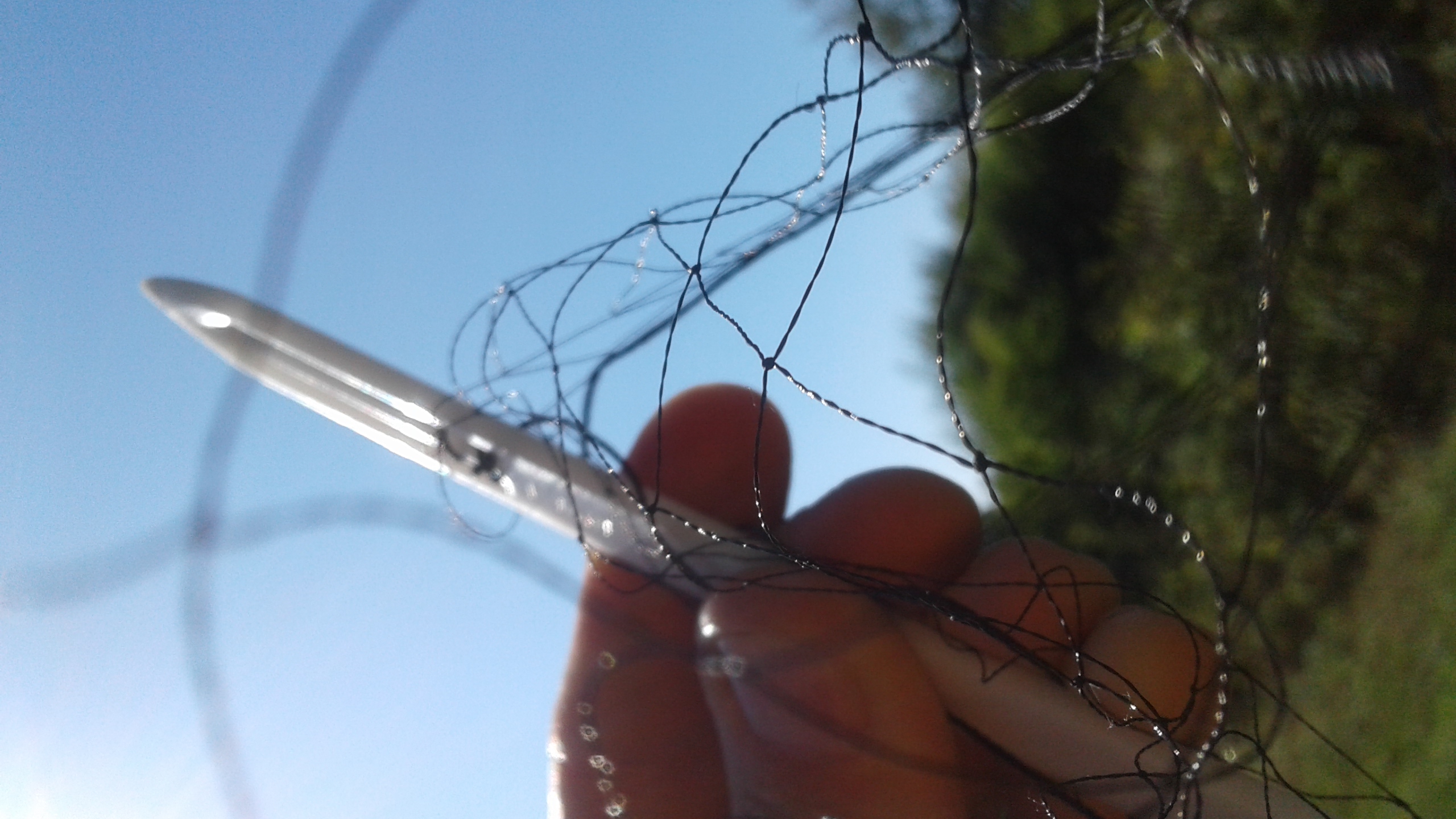
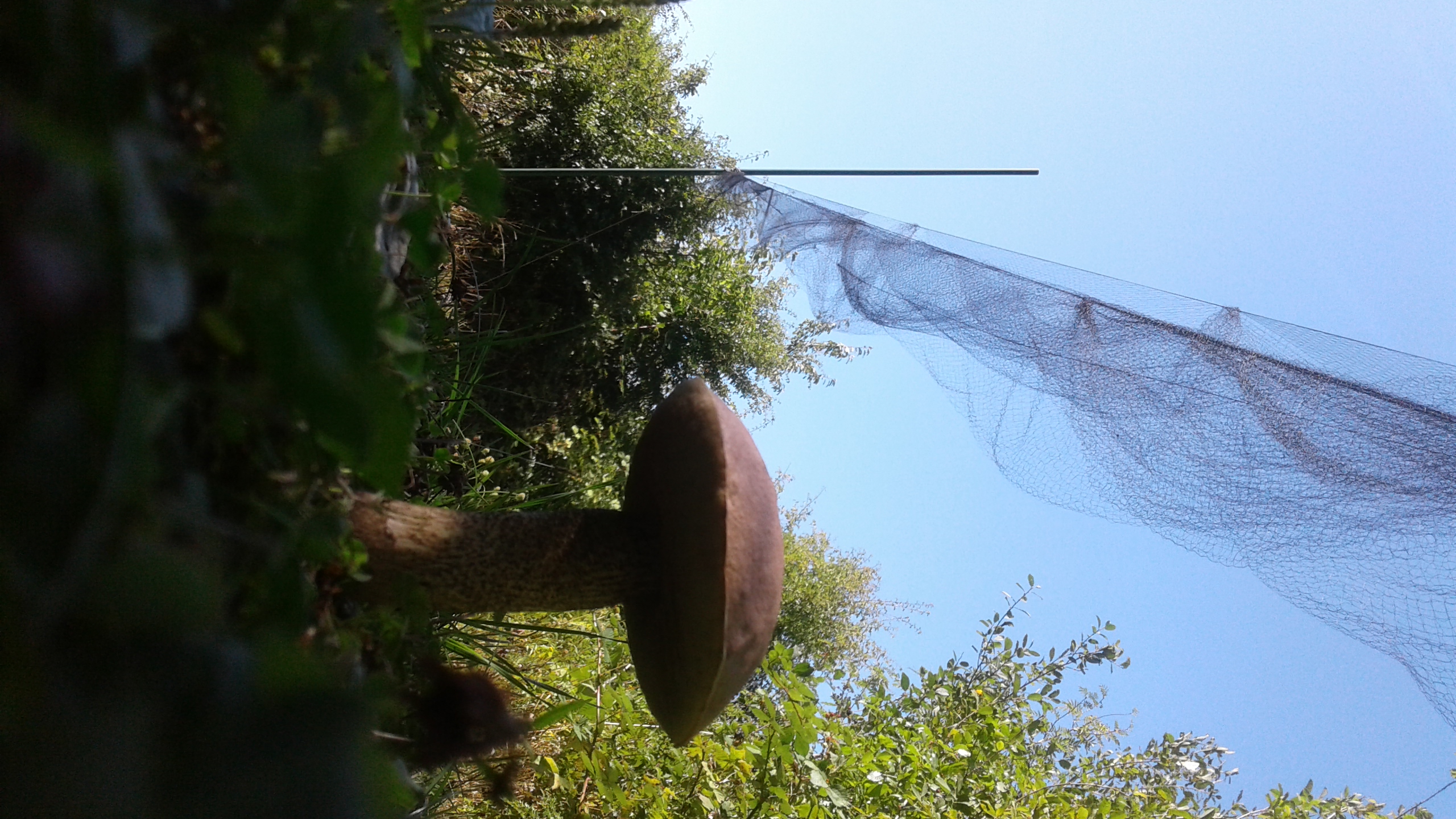
Hvad ved en skrædder om søfart ? Well, måske i det mindste hvordan man bøder, for det er ikke helt nemt og slet ik' en dårlig ting at ku'
Nettene holder ik’ ved for evigt og lidt vedligehold skal til for at bøde netmasker og lukke små huller, selvom der ikke er meget at gøre for at bremse den overordnede mørning af nettene som følge af at stå i vind og vejr (UV-stråling) sæson efter sæson.
Det var kort om godt om måske vores vigtigste udstyr her på GFU.
Søndag vågnede vi forresten til stjernehimmel og en stille have. Vi formoder at de fleste trækfugle var fløjet over os gennem natten, og ved daggry tømtes haven hurtig for øvrige fugle inden himlen nåede at blive overskyet. Til slut blev det således kun til en kvart morgens efterårsvejr, hvor vi dog nåede 37 nymærkninger, inden skydækket veg for sensommersolen.
Spurvehøge var tilstede i-og-over matriklen throughout. Af den håndfuld der kort ramte nettene fik vi mærket to unge fugle. Det er de yngre spurvehøge der trækker først, i hælene på deres hovedretter – men ude på Odden, hvor der blev set mere end 200 i dag, var der mange adulte iblandt.
Dagens ringmærkningstal (28/08/2022):
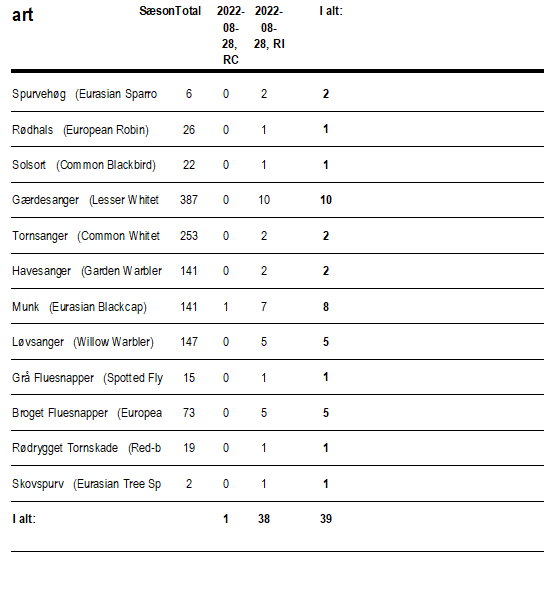
Heldigvis er en køligere stemning langt om længe ankommet til Gedser Odde, altså – vejrmæssigt. Lars Ulrich har taget stafetten fra Henrik og bliver indtil midt på næste måned.
Begyndelsen af næste uge byder også på besøg af Ole Friis, og så kommer Anne som bliver hele efteråret på stationen i ringmærkningsregi.
På stationen: Adam, Lars Ulrich Rasmussen
Så kom regnen
Da vejrudsigten havde lovet regn om natten og muligvis morgen også tjekkede vi radaren før vi satte nettene op og det så fint ud, men allerede en halv time efter måtte vi klappe nettene og holde pause til 8.45 da der kom regn.
Det var ret tydeligt at der var vejrskift da der var flere fugle at se i haven, og dagens total blev også ganske pæn selv om der var pause i den bedste tid for fangsten.
I morgen skal det blive stille vejr og tørt, så der regner vi med at fange en masse fugle.
Dagens ringmærkning og kontroller/Todays ringing and recaptures:
Jernspurv/Dunnock 0/1
Rødhals/Robin 1/0
Nattergal/Thrush nightingale 1/0
Rødstjert/Redstart 5/0
Solsort 0/1
Rørsanger/Reed warbler 2/0
Gulbug/Icterine warbler 1/0
Gærdesanger/Lesser whitethroat 3/1
Tornsanger/Whitethroat 5/0
Havesanger/Garden warbler 3/0
Munk/Blackcap 1/0
Løvsanger/Willow warbler 2/0
Broget fluesnapper/Pied flycatcher 6/0
Stillits/Goldfinch 2/0
Total 32/3
På stationen: Henrik Jørgensen, A
Over and Out
Today we were ringers in the mist. Shortly after a murky dawn a mist drifted in and we went around to mostly empty nets. With the mist few birds were moving; or calling for that matter. Consequently our day total was low but not without some quality. This quality was expressed in several ways. Firstly the "lake" nets were open and though they were not as productive as yesterday a couple of young goldfinch went into the nets. Though these juveniles have not yet attained the stunning beauty of their parents they are well on their way in their post-juvenile moult with their wings already resplendently black, white and gold.
And Chris had the good fortune of two good rounds in that he extracted: common linnet, tree pipit, common rosefinch and spotted flycatcher; then two female pied flycatchers. He enjoyed handling and processing these birds as he has with all the birds he has experienced during his stay at Gedser. He leaves tomorrow having enjoyed re-acquainting himself with warblers; seeing and ringing a red-breasted flycatcher and the very positive ringing experience here at Denmark's southern most point.
The afternoon was spent doing various chores around the houe, garden and in the pond.
So with that it is over and out for Chris as he returns to Germany to get back into numerous woodland birds, notably various tits. He will miss the variety of birds encountered here.
People at the station: Henrik Jørgensen, Chris Sharp and Adam Qvist (who arrived quietly in the night).
| Species | Species | Ringed | Retrap |
| Skovpiber | Tree Pipit | 2 | |
| Solsort | Common Blackbird | 2 | |
| Gæresanger | Lesser Whitethroat | 4 | 3 |
| Tornsanger | Common Whitethroat | 1 | |
| Havesanger | Garden Warbler | 4 | |
| Munk | Eurasian Blackcap | 1 | 2 |
| Løvsanger | Willow Warbler | 1 | |
| Grå Fluesnapper | Spotted Flycatcher | 1 | |
| Broget Fluesnapper | Eurasian Pied Flycatcher | 2 | |
| Musvit | Great Tit | 3 | |
| Stillits | European Goldfinch | 2 | |
| Tomirisk | Common Linnet | 1 | |
| Kamindompap | Common Rosefinch | 1 | |
| 20 | 10 |
Copulating
Well, that's got your attention!
Today Chris had an extraction tick (new species to remove from the nets). A consequence of bird ringers using mist nets is that they occasionally catch other animals. Chris has, previously, extracted from mist nets various bats, butterflies and large beetles; hornets, wasps, dragonflies, frogs; and a toad that had mysteriously got into the second net panel.
This morning's new extraction was not a new species - dragonflies again; but it was a copulating pair. The nuptial pair were conjoined in typical dragonfly fashion at their abdomen and thorax, so forming a flying "heart-shaped" couple. With patience and care dragonflies can be extracted without harming them. This was done, and the pair flew-off; their coitous uninterupted. Hopefully they found a suitable wet spot for the female to lay her fertilised eggs.
After the standard session in the ringing garden Henrik and Chris opened some nets at the pond as swallows, yellow wagtails and good numbers of goldfinch had been seen flying around. Also, in the early morning - dawn - tree pipits had been briefly heard. It was a success with some of all the above mentioned species being caught. Then the final bird out of those nets was a pleasant surprise: a stonechat. From a distance it appeared to be a juvenile but upon extraction it was an adult male in advanced moult; despite its somewhat tatty appearance it was an interesting bird to study and ring.
People at the station: Henrik Jørgensen and Chris Sharp
| Species | Species | Ringed | Retrap |
| Landsvale | Barn Swallow | 1 | |
| Skovpiber | Tree Pipit | 1 | |
| Gul Vpistijert | Wetern Yellow Wagtail | 5 | |
| Nattergal | Thrush Nightingale | 1 | |
| Sortstrubet Bynkefugl | Eurasian Stonechat | 1 | |
| Solsort | Common Blackbird | 1 | |
| Gærdesanger | Lesser Whitethroat | 8 | 1 |
| Tornsanger | Common Whitethroat | 6 | |
| Havesanger | Garden Warbler | 2 | 1 |
| Munk | Eurasian Blackcap | 9 | 5 |
| Løvsanger | Willow Warbler | 2 | |
| Broget Fluesnapper | Pied Flycatcher | 1 | |
| Rødrygget Tornskade | Red-backed Shrike | 1 | |
| Stillits | Europen Goldfinch | 2 | |
| 39 | 9 |
A Lesser day - not really?
As expected today's catch was down on yesterdays. This trend is expected to continue for the next few days as the strong south-easterly wind seems to be inhibiting most migratory movement. For visiting ringers this can sometimes be a negative but its the reality of the functioning of a bird observatory. A bird observatory does not necessarily equate to large numbers of birds passing through each day (O, how we wish)! Its an observatory and it observes, records and with long term data sets compiled from consistent and constant effort monitors trends in avian populations.
So we didn't catch much today but it allowed us to do other jobs that are an essential part of observatory work, such as: clearing brambles from the rides and paths; cleaning bird bags, drying them in the sun, and then chasing the few that blew down the proverbial garden path; and a bit more interaction with some passing visitors.
The only birds that seemed to be moving were starlings - flying strongly out over the sea; goldfinches and from mid-morning some yellow wagtails. Our captures of these last two species came in that period.
Tomorrow we suspect that the catch will be even lower - how one sometimes longs to be wrong! But that is how it goes.
People at the station: Henrik Jørgensen and Chris Sharp
| Species | Species | Ringed | Retraps |
| Spuvehøg | Sparrowhawk | 1 | |
| Gul Vipstjert | Yellow Wagtail | 2 | |
| Nattergal | Thrush Nightingale | 1 | |
| Rødstjert | Common Redstart | 1 | |
| Solsort | Common Blackbird | 2 | |
| Kærsanger | Marsh Warbler | 2 | |
| Gærdesanger | Lesser Whitethroat | 4 | |
| Tornsanger | Common Whitethroat | 3 | |
| Havesanger | Garden Warbler | 2 | 1 |
| Munk | Eurasian Blackcap | 10 | 1 |
| Broget Fluesnapper | Eurpoean Pied Flycatcher | 1 | |
| Stillits | European Goldfinch | 1 | 1 |
| 27 | 6 |
Into Lolland
From the start it was quiet. And quiet it remained. Few birds in the garden, so consequently few birds in the nets. The only birds flitting around in any notable numbers were goldfinch and they are stubbonly staying out of the nets.
So we, Henrik and Chris, took Gert, a regular visitor and volunteer here, up on his offer to go on a little birding trip to Lolland. Precisely we visited the Maribo Lakes. For Chris this was a fine opportunity to see another part of Denmark. And for all three of us it was a grand afternoon's birdwatching. The highlights were black swarms of coot floating across the lakes with mallard, gadwall and good numbers of pochard, mixed in amongst them. Several raptors were seen, including several white-tailed eagles presumably from the local breeding population. For all of us the best moment was when we saw a white-tailed eagle, osprey and a black-kite in the same binocular view - that does not happen often. Wonderful! And thank-you Gert.
And tomorrow, as the cliche goes is another day but we suspect, hopefully wrongly, that it will be another quiet day; a change in wind direction is required.
People at the station: Henrik Jørgensen and Chris Sharp
| Species | Species | Ringed | Retrap |
| Landsvale | Swallow | 1 | |
| Nattergal | Thrush Nighingale | 1 | |
| Solsort | Blackbird | 1 | |
| Rørsanger | Reed Warbler | 1 | |
| Gærdesanger | Lesser Whitethroat | 6 | 2 |
| Tornsanger | Common Whtethroat | 5 | 4 |
| Havesanger | Garden Warbler | 5 | 2 |
| Munk | Eurasian Blackcap | 5 | 1 |
| Gransanger | Common Chiffchaff | 1 | |
| Løvsanger | Willow Warbler | 5 | |
| Broget Fluesnapper | European Pied Flycatcher | 3 | |
| Træløber | Treecreeper | 1 | |
| 34 | 10 |
Juveniles
Today's figures were a respectacle seventy-seven birds caught of eighteen species, fairly typical of the last ten days or so. These figures are a fine summary of the catch but do not indicate much else about the birds passing through; almost certainly the birds caught at Gedser in this period are migrants. The basic data for each bird includes biometrics like weight and wing-length; age, and where possible the bird's sex; and an indicative "measurement" of fat.
Without exception all the birds were carrying some fat. This fat can be seen as accumulated deposits in the birds' abdomen and in the furcular pit - a depression at the top of the chest and extending into the throat. This fat, along with lipid deposits in the liver, provide the fuel for the birds' migratory flights. Also, in the fats utilization some metabolic water is released which contributes to the birds thermo-regulation during flight.
All but five of the birds captured today were juveniles. This type of figure is not unusual in captures at ringing sites across Europe at this time of the year. Information of this nature is used in several ways, for example: it allows an assessment of how successful a species has been this year in its breeding efforts. This informaton's value is increased when it is compared to long-term data - that comes from continuous and sustained ringing projects through the years.
The majority of juvenile birds we caught today will rapidly move-on. Today the three young ringers Stav, Daniel and Esben moved on too. They had a good week's ringing and made a valued contribution to the observatory's work - thank-you!
In the afternoon Chris opened the nets at the pond because there was an obvious movement of yellow wagtails and goldfinches; he caught and ringed several, which unsurprisingly were fatty juveniles.
People at the station today were: Henrik Jørgensen, Chris Sharp, Stav Shay, Daniel Bloche and Esben Hansen.
And the birds were:
Jernspurv/Dunnock 0/1
Rødhals/Robin 1/0
Nattergal/Thrush Nightingale 1/0
Husrødstjert/Black Redstart 1/0
Rødstjert/Common Redstart 1/2
Solsort/Blackbird 0/1
Gulbug/Icterine Warbler 1/0
Gærdesanger/Lesser Whitethroat 18/2
Tornsanger/Common Whitethroat 8/0
Havesanger/Garden Warbler 6/1
Munk/Eurasian Blackcap 13/1
Løvsanger/Willow Warbler 6/0
Grå Fluesnapper/Spotted Flycatcher 1/0
Musvit/Great Tit 1/1
Rødrygget Tornskade/Red-backed Shrike 1/0
Stillits/Goldfinch 2/0
Gul Vipstjert/Yellow Wagtail 6/0
Digesvale/Sand Martin 1/0
Total 77/9 of 18 species
Hula Valley to Gedser
Tomorrow morning will be the last morning's ringing for Daniel, Esben and Stav. It has been a good trip for them ringing a reasonable number of birds. For Stav, from Israel she has not only enjoyed some new birds but the weather too - it is noticeably cooler than the Hula Valley. During her visit she has had the opportunity to ring several new species, including a new one today: yellow wagtail, bringing her number of ringing ticks this week to fourteeen.
Apart from the blue tit which caused her much joy earlier in the week, several of the other birds she has enjoyed have been: sparrowhawk, common linnet, grasshopper warbler, wryneck and yellowhammer.
The sparrowhawk was a pleasing bird for her as it was the first raptor that she had handled and ringed, while the processing had a frission of excitement about because of the birds talons, skillfully avoided, just. A yellowhammer got her very excited not just because of the birds vivid colours but it is a bird that is extremely rare in Israel, so not only a ringing tick but a totally new species too. This also applied to the linnet.
Though grasshopper warbler and wryneck occur in Israel they are exceptionally rare, so getting to handle both species was a double treat. The wonderful colouring and patterning on the wryneck is a strong image that she will take away with her, along with very pleasant memories of a location that she has thoroughtly enjoyed: isolation, beach, butterflies, birds, general ambience accenuated by vivid greens; and pleasant people and company who she thanks for the wonderful experience.
Today we were also joined, for the second morning, by Robin and Mathi and their father; both the boys are interested in becoming ringers. They certainly showed interest and knowledge.
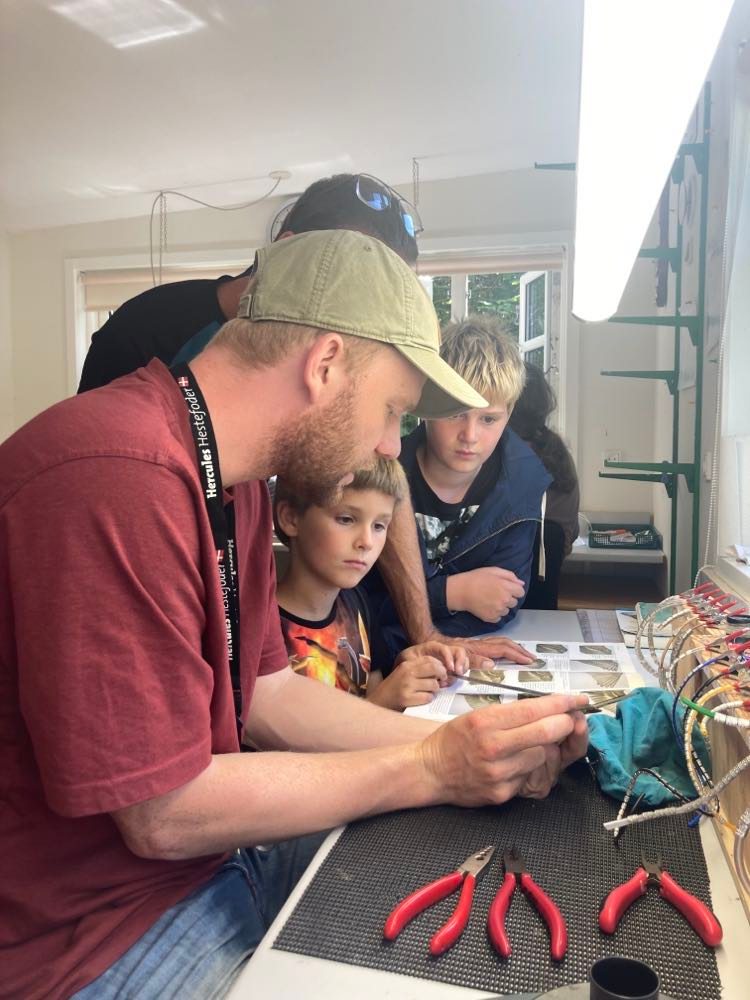
Esben explaining bird ringing to Robin and Mathi
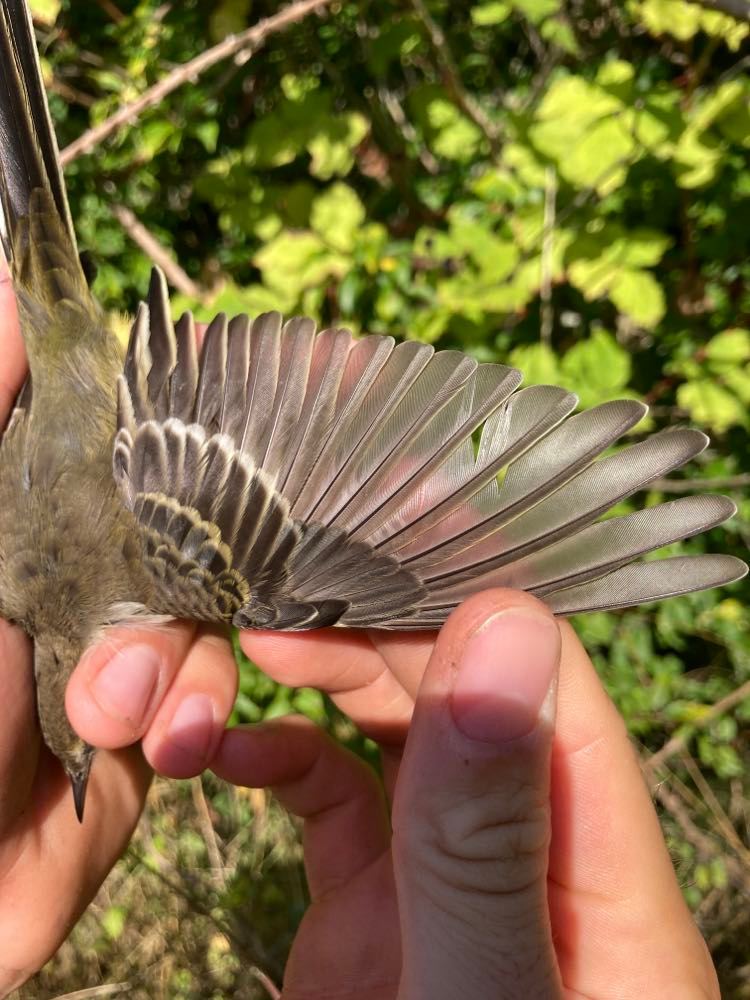
Wing of a 1k Yellow Wagtail (Gul Vipstjert)
People present at the bird observatory: Henrick Jorgensen, Chris Sharp, Shave Shay, Esben Hansen and Daniel Bloche
Slow Sausages
For British birdwatchers and ringers of a certain age they may remember a television advert for Danish bacon with the jingle: Danish written all through it; and very tasty bacon it was too. Today we did not have bacon but we had sausages of the real variety and the avian variety; first the feathered sausages.
Many of the birds caught today had high fat scores, several with fat scores of seven; these little fatties were nicknamed flying sausages. A particular feathered sausage was a common whitethroat with a fat score of seven and a weight of 21.1g. This, crudely, means it was carrying seven grams in fat to fuel its migration but the figure is actually quite amazing. That means it's weight was about fifty percent up on its normal weight. If this occured in humans in the autum and winter imagine the amount of clothing we'd have to have in our wardrobes; let alone the numerous cardiac health issues we'd have!
Though we had less birds today there was still quality in the catch: another wryneck, a common rosefinch, and finally not one, but two sparrowhawks caught in the nets. The wryneck and sparrowhawks were much appreciated by a large number of "Friends of Gedser" who gathered here to share a barbeque together. These people are the unsung heros of places like Gedser Bird Observatory in the numerous voluntary hours they put into maintaining the site, facilities and the general running of the observatory. And their barbeque included a selection of very tasty, and much appreciated suasages accompanied by a fine selection of salads.
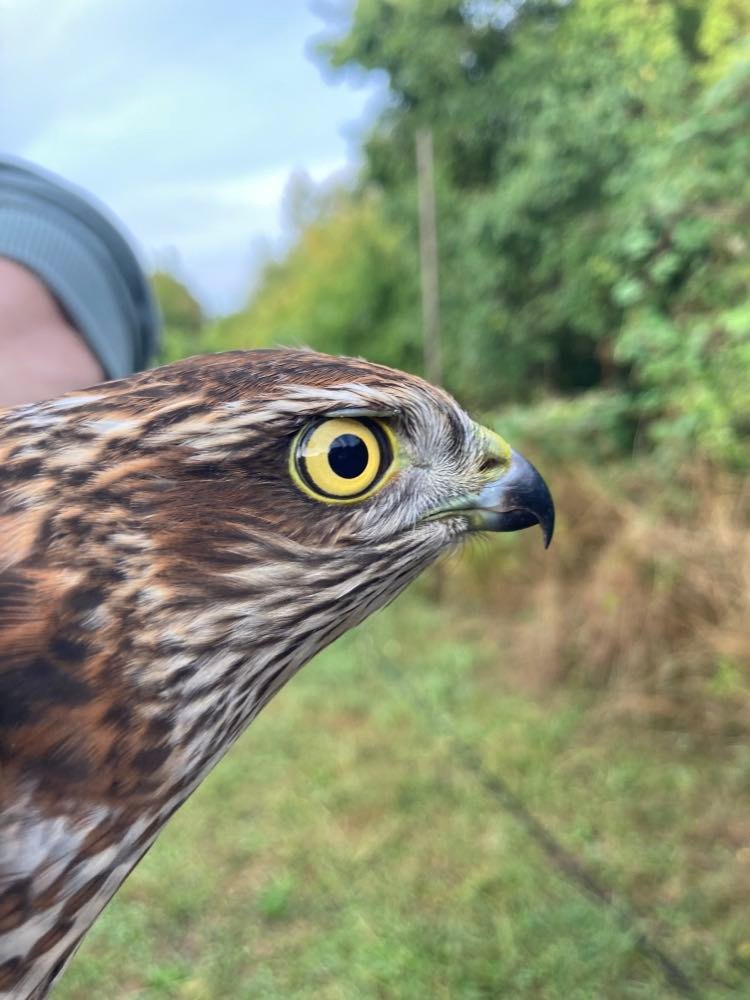
Sparrowhawk
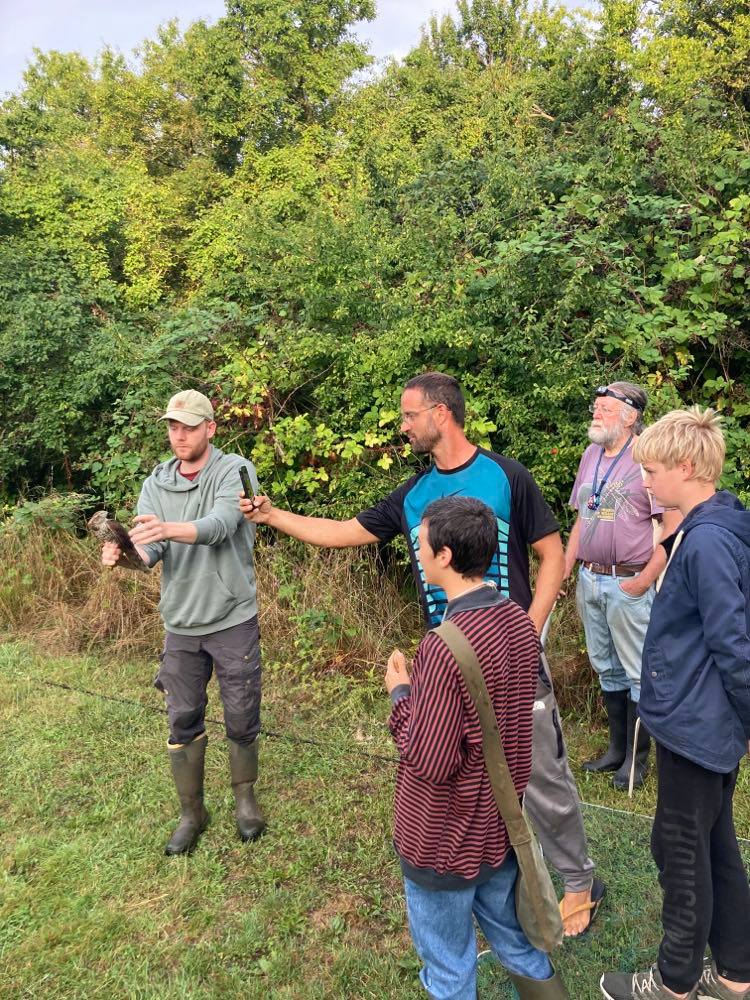
Showing the Sparrowhawk

Ageing the Rosefinch
Not only were two sparrowhawks caught in the net many more were seen migrating over the oberservatory and these were in the company of other raptors, including: buzzard, honez buzzard, osprey, kestrel, red-footed falcon and white-tailed eagle. In the afternoon we were contacted about an injured juvenile white-tailed eagle; this was collected and taken to a re-hablitation center.
People at the station: Hendrick Jørgensen, Chris Sharp, Daniel Bloche, Esben Hansen, Shav Shay and many Friends of Gedser Bird Observatory.
